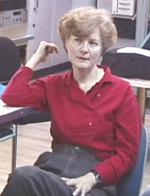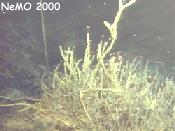| |
Participant
Interview:
Verena Tunnicliffe
Biologist
University of Victoria
Jeff: Could you comment
on being a female scientist on board ship?
Verena: In oceanography it's been a long haul, but things have changed
dramatically in the last ten years. Now you see women on the crew of the
ship. You never saw women on the crew or on the bridge when I started.
A turnover of generations from the Merchant Marines has helped. A lot
of the guys on the ship's crew that were either Navy or Merchant Marines
are retiring so you're starting to see people with a non-military attitude.
Also, there is a general move toward women getting into professions that
they were originally kept out of. When I first started going to sea some
guys on the ship were very upset that I was there. I was not allowed to
go into the crew's mess or allowed below decks.
Jeff: What do you find
most fascinating about vent communities?
Verena: The tremendous biomass of the system. It's the highest biomass
community in the ocean. Certain kinds of vents are comparable to soybean
crops in terms of the amount of productivity that are there. A lot of
that goes back to the microbial stuff. There's a mystery there that's
interesting, but what captured me the most in doing the work was the evolutionary
history of the animals. I wanted to know where they had come from in time
and space. How is it they look like that? Most of the animals are new
to science. It's the unusual nature of the animals. To me finding a new
species is really exciting because it's a detective story, trying to figure
out what it is, what it could be doing, and where it fits in. I take a
lot of delight in that. There's a real feeling of wonder at an alien world
which is still part of our planet and something we know so little about.
I've made over 140 submersible dives and I've seen a lot of the ocean
floor. Yet, every time I come out here it's still new. Whether it's new
animals or new geology or new water properties. There's still so little
we know. In a way it's very remote and you don't understand how somebody
in Nebraska cares about the bottom of the ocean. But we still live in
a connected world and with climate change issues, the world still has
to care about what's happening in the deep ocean.
Jeff: Where would you like
to see NeMO going in the future?
Verena: I think that NeMO is going to do two things. The first is to get
more detailed local information and the second is to begin compiling the
regional information. We've looked extensively at Cleft and Axial and
Co-Axial and I think it would be interesting for NeMO to go back to those
places and set a baseline. There's going to be another eruption out here
and it will either be Cleft or Axial/Co-Axial. I think NeMO, as a local
observatory on Axial, has a lot of potential. Not just in case there's
an eruption, but also to understand long-term dynamics. NeMO's a wonderful
program and I've always been grateful to NOAA. They are a great group
to work with.
|
|

Vernena discusses life at
sea .

Bag City Vent before  camera was deployed. MTR mooring in background of tube worm colony which
the camera is sending photos via satellite.
camera was deployed. MTR mooring in background of tube worm colony which
the camera is sending photos via satellite.
|
|

